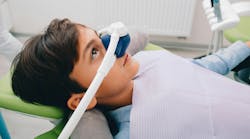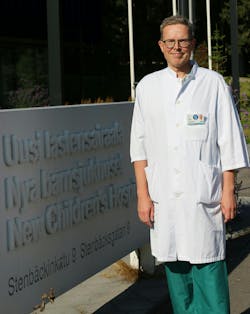Surge in severe pediatric dental issues necessitates dental care under general anesthesia and innovative therapies
Severe dental problems in young children have increased dramatically in many Western countries, including Finland. The Nordic country’s largest health-care provider, HUS Helsinki University Hospital, receives about 150 new referrals for pediatric dental care under general anesthesia every month. This number has increased significantly compared to prepandemic years, according to Dr. Heikki Alapulli, Deputy Chief Dental Officer at HUS.
Last year, HUS Helsinki University Hospital received more than 2,000 referrals for pediatric (0–16 years) dental care under general anesthesia, notes Dr. Alapulli. “By the time a child’s teeth require sedation for treatment, the damage in the mouth is already extensive, often requiring the extraction of several teeth.”
Dr. Alapulli emphasizes that tooth decay and gum disease are prevalent issues among children. Dental caries represents the most prevalent chronic condition globally and a leading cause of dental restoration failures such as fillings, crowns, and bridges in adults. This disease stems from dysbiosis in the oral microbiome, involving various bacterial species such as Streptococcus mutans and Lactobacillus. Sugar consumption plays a significant role in exacerbating this dysbiosis, thereby influencing the progression of caries development.1
According to a Swedish study, up to 20% of children harbor a particularly aggressive strain of S. mutans, known for its high efficacy in causing tooth decay, underscoring the importance of rigorous oral hygiene practices from an early age.2
“Oral health problems are common in children if teeth are not cleaned thoroughly. Inflammation of the gums causes low-grade inflammation in the body, which is known to be a risk factor for cardiovascular disease in adults,” explains Dr. Alapulli. Poor oral hygiene in childhood can also lead to periodontitis in adulthood, so “good oral hygiene habits learned in childhood are critical to preventing oral disease in adulthood,” he says.
Dental care under general anesthesia for individual needs
“Dental care under general anesthesia is an effective solution for many patient groups that require special attention to maintain oral health, including children but also patients who often struggle with the stress and discomfort of dental visits,” says Mauri Numminen, founder of Dental Hospital Unioni45.
In August 2022, Numminen opened the Unioni45 dental clinic in Helsinki, Finland, specializing in dental care for patients with dental fear and providing dental care under general anesthesia as a core service. Since then, his team has provided dental care under general anesthesia services to public sector clients and private patients throughout Finland.
“Unioni45 also has several mobile teams, whose anesthetists and nurses travel around Finland to treat patients in the country’s central hospitals, health centers, and private dental clinics.” Numminen adds that children need general anesthesia when their oral health requires extensive procedures and long treatment times. This approach ensures painless and effective care.
He says, “In general, dental care under general anesthesia is recommended when a child’s oral health treatment requires more than four visits. General anesthesia may also be required for children with special needs, such as those on the autism spectrum, which can make cooperation at the dental clinic difficult.”
Many adult patients also require general anesthesia for dental procedures. Up to 10% of adults suffer from severe dental phobia, leading to neglect of oral health.3 However, access to procedures under general anesthesia for adults is often hindered by long waiting lists in public dental services and high costs in the private sector, leaving many without necessary care and exacerbating oral health issues.
Numminen advises that dental care under general anesthesia should be scheduled before the patient’s oral condition becomes severe to avoid extractions and keep costs reasonable.
Good oral health has broader implications than just a beautiful smile. Maintaining oral health is crucial to overall well-being, as poor oral health has been linked to serious illnesses such as cardiovascular disease, diabetes, Alzheimer’s disease, and even certain types of cancer.4
“Dental phobia is a real problem that doesn’t just go away with a chat. Dental treatments under general anesthesia can be a good option, especially for some young adults,” Numminen notes.
Concerns about children’s oral health
Numminen expressed concern about the increasing number of children needing dental care under general anesthesia in Finland, as evidenced by longer wait times in the Helsinki and Uusimaa (HUS) and Pirkanmaa hospital districts.
“The current state of children’s and adolescents’ teeth has a direct impact on the frequency of dental care under general anesthesia,” he said.
Access to such care in the public sector can take months, which is why Unioni45 private dental hospital sees a high volume of patients. “At best, our clinic has four dentists working every day, each treating four patients per shift. Pediatric dental care at our clinic is always provided by a dentist specialized in pediatric patients, as children’s dental care is often demanding and requires special expertise,” Numminen explains.
Deteriorating oral health among children and adolescents is not just a Finnish problem. For example, the British Oral Health Foundation has called for urgent action to improve children’s oral health, noting that many children under the age of 19 require tooth extractions under general anesthesia due to poor dental health. There is also an overreliance on extractions of primary teeth in young children, which can damage permanent teeth in the long term.5
Numminen notes that children’s dental health in Finland is highly polarized. Although pediatric oral health care is generally good according to caries indices, the situation varies greatly from family to family. Poor oral health is often prominent in families struggling with other life challenges, such as mental health problems and substance abuse.
Another notable trend in the Nordic country is the increasing need for sedation dentistry among immigrant families.6 Numminen says, “About 80% of the children we treat come from immigrant families. Although these children are otherwise healthy and well cared for, their dental condition is often very worrying. Contributing factors include poor oral hygiene and changes in diet, such as switching to a carbohydrate-rich Finnish diet, which can be hard on oral health. Additionally, fluoride and xylitol, which are common in Finland, may be unfamiliar to many immigrants.”
Inspiration for improved oral self-care
Numminen is pleased to see that many young adult patients are motivated to improve their oral hygiene after successful dental treatment under general anesthesia. About 70% of private patients continue with active dental care during a two-year follow-up period, he says.
“Successful treatment with sedation motivates patients to take greater responsibility for their oral health. This decision may also be influenced by cost considerations. Those who have undergone extensive dental treatment under general anesthesia usually return to regular dental care,” Numminen continues.
He suggests this group of patients may be particularly motivated to try an antibacterial, light-activated therapy (Lumoral) as part of their daily oral hygiene routine. The Lumoral method, developed by Finnish scientists, is not yet available in the United States.
As thorough self-care is essential for maintaining oral health, Numminen's dental clinic is collaborating with Finnish health technology company Koite Health Ltd. As part of this collaboration, the hospital offers private sedation dental patients the antibacterial method to enhance their oral self-care routine.
This treatment is an excellent adjunct for patients who require enhanced oral self-care following sedation dentistry procedures. “These patients may have numerous bacterial problems in their mouths, or they may be anxious about visiting the dentist and hygienist. Adding Lumoral treatment to their normal oral hygiene routine can help avoid the need for major dental procedures in the future,” Numminen says.
Selective action protects healthy oral bacteria
One key advantage of this antibacterial method is its selectivity. Lumoral primarily targets harmful oral bacteria, unlike other antimicrobial mouthwashes such as chlorhexidine. Lumorinse mouthwash, an integral therapeutical component, is a strong, plaque-binding mouthwash that doesn’t affect normal oral flora even with prolonged use. The antibacterial effect is achieved through the interaction between dual-light aPDT and the dye in the mouthwash that binds locally on the plaque, preventing gum inflammation and eliminating unhealthy bacteria causing tooth decay while supporting healthy flora.7,8
Editor’s note: This article first appeared in Clinical Insights newsletter, a publication of the Endeavor Business Media Dental Group. Read more articles and subscribe.
References
- Zhan L. Rebalancing the caries microbiome dysbiosis: targeted treatment and sugar alcohols. Adv Dent Res. 2018;29(1):110-116. doi:10.1177/0022034517736498
- Esberg A, Sheng N, Mårell L, et al. Streptococcus mutans adhesin biotypes that match and predict individual caries development. EBioMedicine. 2017; 24:205-215. doi:10.1016/j.ebiom.2017.09.027
- Agarwal S, Chandak M, Reche A, Singh PV. The prevalence of dental fear and its relationship to dental caries and gingival diseases among school children in Wardha. Cureus. 2023;15(10):e46360. doi:10.7759/cureus.46360
- Bhatnagar DM. Oral health: a gateway to overall health. Contemp Clin Dent. 2021;12(3):211-212. doi:10.4103/ccd.ccd_597_21
- Oral Health Foundation calls for action after a huge rise in childhood tooth extractions under general anaesthetic. Oral Health Foundation. February 24, 2023. https://www.dentalhealth.org/news/oral-health-foundation-calls-for-action-after-a-huge-rise-in-childhood-tooth-extractions-under-general-anaesthetic
- Mattila A, Ghaderi P, Tervonen L, et al. Self-reported oral health and use of dental services among asylum seekers and immigrants in Finland–a pilot study. Eur J Public Health. 2016;26(6):1006-1010. doi:10.1093/eurpub/ckw116
- Trujiilo K, Räisänen IT, Sorsa T, Pätilä T. Repeated daily use of dual-light antibacterial photodynamic therapy in periodontal disease—a case report. Dent J (Basel). 2022;10(9):163. doi:10.3390/dj10090163
- Pakarinen S, Saarela RKT, Välimaa H, et al. Home-applied dual-light photodynamic therapy in the treatment of stable chronic periodontitis (HOPE-CP)—three-month interim results. Dent J (Basel). 2022;10(11):206. doi:10.3390/dj10110206










